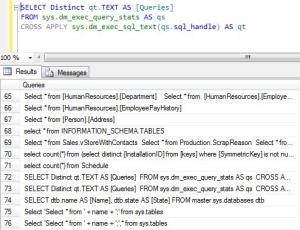In my previous article, I wrote about Executing Stored Procedure with Result Sets. I utilized this new feature introduced in SQL Server 2012 many times and it is very handy, when it comes to manipulate stored procedure result sets.
Today, I was reading a question related to this topic in a forum where a community member tried to manipulate stored procedure result set with result sets keyword and then insert it into a temporary table. But it gives an error.
Let me create few examples to explain the problem :
Example 1 :
In this example, we will insert the result set of a stored procedure in a temporary table without using result set keyword and it works fine.
Use AdventureWorks2012 GO Create Table #temp ( [DepartmentID] int, [Name] varchar(50) ) GO Create PROCEDURE SP_ResultSet_Example1 as Select [DepartmentID] ,[Name] from [HumanResources].[Department] GO Insert into #temp EXEC SP_ResultSet_Example1 GO Select * from #temp order by [DepartmentID]
Example 2 :
In this example, we will insert the result set of a stored procedure in a temporary table with result sets keyword. It gives an error .
Use AdventureWorks2012 GO Create Table #temp ( [DepartmentID] int, [Name] varchar(50) ) GO Create PROCEDURE SP_ResultSet_Example1 as Select [DepartmentID] ,[Name] from [HumanResources].[Department] GO Insert into #temp EXEC SP_ResultSet_Example1 WITH RESULT SETS ( ([Department ID] int NOT NULL, [Department name] Name NOT NULL)); GO Select * from #temp order by [DepartmentID]
Explanation :
We cannot use result sets keyword, when we need to insert any stored procedure result set into a table. The reason behind this is if we use result sets keyword we can return multiple results with different columns and with different data types from a single stored procedure and this functionality cannot be handled in a single table. As per MSDN ” WITH
Possible execute options. The RESULT SETS options cannot be specified in an INSERT…EXEC statement.” .













